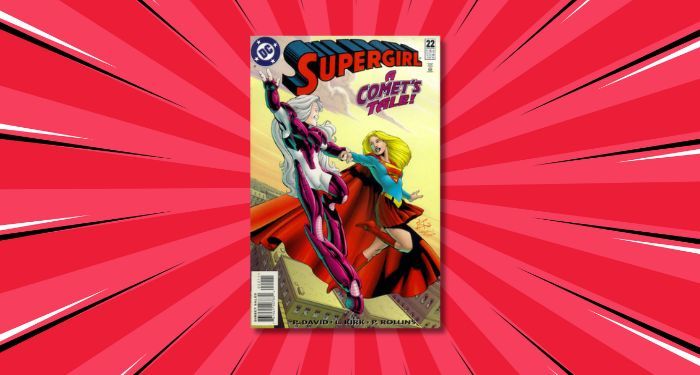
Queer Superhero History: Super Friends
In recent years, mainstream comics publishers like DC and Marvel have made great strides in increasing the LGBTQ+ rep in their universes, though they still have a long way to go. But getting here was a slow and gradual process, with many notable landmarks — and some admitted missteps — along the way. In Queer Superhero History, we’ll look at queer characters in mainstream superhero comics, in (roughly) chronological order, to see how the landscape of LGBTQ+ rep in the genre has changed over time. Today we’ll be looking at two queer Superman supporting characters: Hero and Comet!
Content Warning: The comics discussed include homophobic language, homophobic violence, and self-harm.
We’ve already talked about one of DC’s first significant queer characters, Maggie Sawyer, a police captain in Metropolis and an ally of Superman’s. As DC slowly but surely built up their roster of (admittedly usually very obscure) queer characters in the ’90s, they added two more to the extended Super cast, though not in Clark’s own books. Hero was a friend of Superboy’s; Comet was a friend of Supergirl’s. Coincidentally, not only did they debut within nine months of each other, they’re both shapeshifters, raising interesting questions about the mutability of identity, sexuality, gender, and desire.
Hero Cruz debuted in Superboy and the Ravers #1 by Karl Kesel, Steve Mattsson, and Paul Pelletier. The book’s premise revolves around an intergalactic rave that hops from planet to planet, with superpowered partiers teleporting in and out at will. It is incredibly ’90s (there is a character named Phat-Boy).
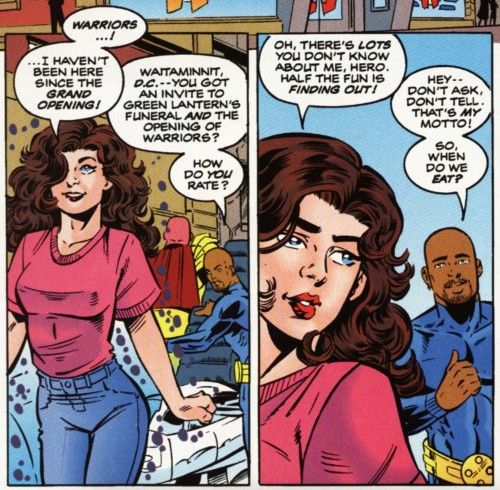
Hero is one of the guests at the rave, even though he doesn’t have powers of his own, just a vest that generates a force field. Soon, though, he upgrades to something even better: the H-Dial.
The H-Dial first appeared in a 1966 comic called Dial H for Hero, though it’s reappeared many times since. It’s essentially a rotary dial like on an old telephone, but instead of numbers, it displays the letters H-E-R-O. When its bearer dials the word “HERO,” they transform into a number of (mostly) unique superhero personas.
Hero uses the dial to transform into a number of superheroes, including Titanic, a massive, macho, quintessentially ’90s hero. All of a sudden, he seems interested in his female teammate Sparx. This is a bit of a surprise, especially to Sparx. Careful readers might have already noticed Hero hastily changing the conversation or leaving it entirely whenever she flirts with him. Most blatantly, when she teases him about her secrets, he responds with “Don’t ask, don’t tell. That’s my motto!” He also sports an earring in his right ear, like his predecessor Extraño, with all the supposed coding that implies.
But as Titanic, he tells Sparx: “For the longest time, I’ve wished I could return [your] feelings.” When she asks what’s stopping him, he says “Nothing…now,” and they kiss.
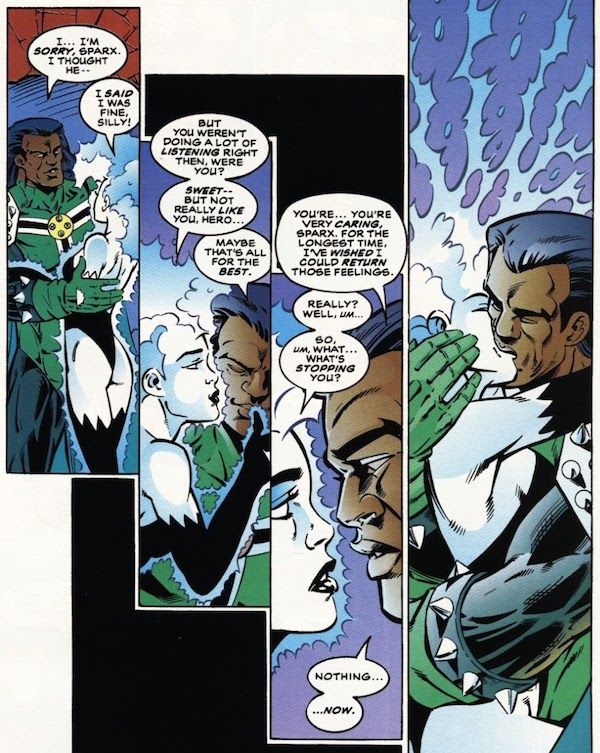
When Hero changes back to himself, however, he starts avoiding a smitten Sparx. Finally, he tells her the truth: he can’t be her boyfriend, because he’s gay.
Sparx doesn’t take it well, accusing Hero of being “unnatural” before flying away in tears. She doesn’t out him to the team, but she continues to make snide remarks, especially after Hero starts spending time with another member of the rave, Leander (get it?). By the final issue of the series, Superboy has figured out enough to tell her to stop being uncool and that there’s nothing wrong with Hero or Leander. She protests that she wishes Hero hadn’t changed, and Hero coldly replies they’re clearly both who they always were, ending both of their arcs on something of a downer note.
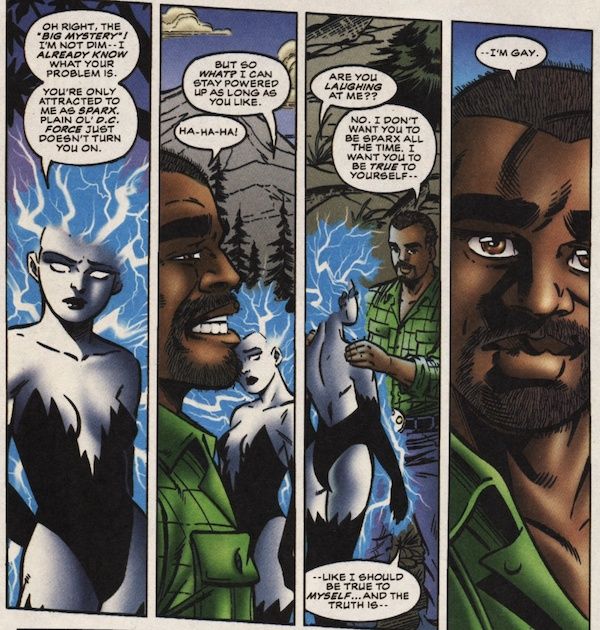
But Sparx does ask a valid question: if Hero is gay, why did he kiss her as Titanic? In fact, a number of Hero’s superhero personas seem to be interested in Sparx. Hero himself can’t explain it; while he admits he’d like to blame it on the H-Dial, he’s pretty sure Titanic and the others “are just different aspects of my psyche.” Later, talking about the H-Dial, he says: “I’ve a theory that each identity you dial up is a sliver of your subconscious…so, if they’re part of you, how can that be bad?”
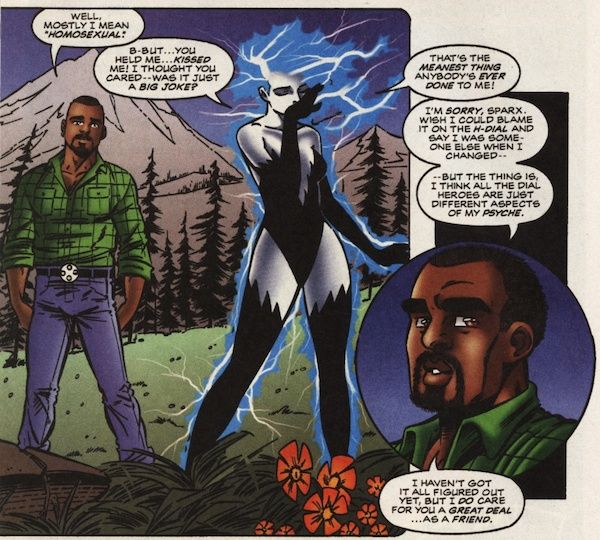
Hero isn’t alone in not totally understanding how the H-Dial works; the past 57 years of comics have been inconsistent about exactly what it is and where the superheroes come from. Superboy and the Ravers alone offers up two further complications: in one issue, Hero turns into Isis, who is not just a preexisting DC hero, but a female one. In another, he turns into the sorcerer Sebastian Faust…while the real Sebastian Faust is already in the room. (Interestingly, while the real Faust is white, Hero’s version, like all of his transformations, is Black. This could imply that race is less mutable than gender and sexuality, but I think it’s probably just a visual shorthand to help readers tell the two apart.) Hero doesn’t have any answers for what any of this means, and Superboy and the Ravers seems content to leave the questions open-ended.
Comet, a supporting character in the 1996 Supergirl series, raises similar questions. Now, you may be familiar with the original version of Comet the Super-Horse, Supergirl’s Silver Age companion. In fact, I’ve already written about what a huge creep he is here. But he’s a) heterosexual as far as I know, and b) a literal horse. So who am I talking about?
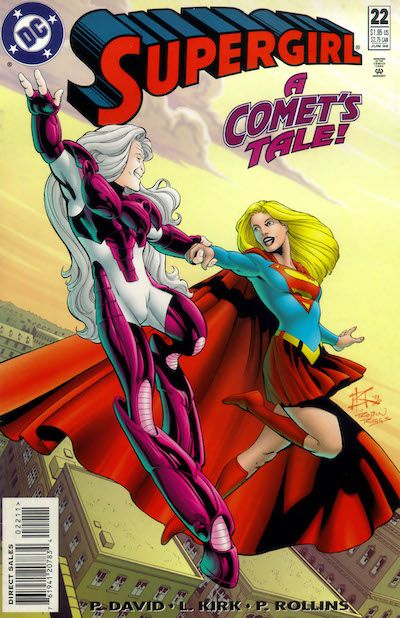
Well, in the ’90s, Supergirl was not the Kara Zor-El of Krypton that most people are familiar with. Due to an editorial mandate that forbade survivors of Krypton other than Superman himself, the original version of Supergirl had been killed off and replaced with Matrix, a shapeshifting protoplasmic being from another dimension who, at the beginning of the 1996 series, merged with a dying human woman named Linda Danvers. This merging not only saved Linda and fused her and Matrix into one being, it also caused her/them to become something called “an Earthborn angel,” with various divine powers on top of her usual Supergirl ones. You know, your basic Wednesday in the DC universe.
In issue #10 (by Peter David and Leonard Kirk), Linda meets a standup comedian named Andrea Martinez, but going by the stage name Andy Jones. Andy immediately displays a pronounced interest in getting to know Linda; that and her short, choppy haircut might have been enough for anyone interested in reading between the lines.
Soon after, a new superhero called Comet arrives on the scene. He is tall and masculine, with long white hair, equine features, and hooves instead of feet. Linda is intensely attracted to him, so much so that she questions if it’s natural.
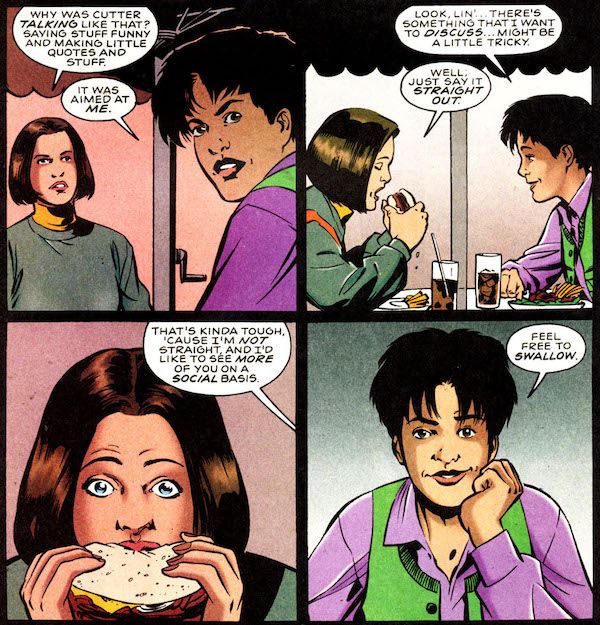
In issue #21, Andy asks out a surprised Linda, who awkwardly but politely declines. Later in the same issue, Supergirl and Comet share a passionate kiss.
You know where this is going, right? Eventually, it’s revealed that the petite, Latina lesbian Andy and the tall, white male Comet are the same person, just as Linda and Supergirl are the same person. See, the original Andy Jones was an ordinary human jockey, but after he was terribly injured during a race, he agreed to become an experimental subject for a sketchy lab, which naturally turned him into a superpowered human-horse hybrid because comics.
Meanwhile, ordinary human woman Andrea Martinez was severely depressed, largely due to her homophobic family, and that depression drove her to do self-destructive things like try to climb Mount Everest solo. When the climb nearly killed her, she was found by Andy, who gave his life to try to save her — a sacrifice that led to them merging into one being, again like Supergirl. They are specifically the Earthborn angel of love (Supergirl is the angel of fire), which is why Linda feels such intense attraction to Comet in his male form.
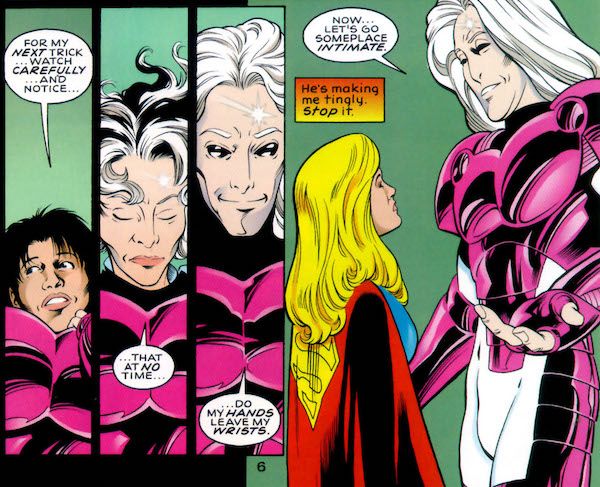
Andy defines herself as a lesbian, using she/her pronouns as Andy and he/him pronouns as Comet (which I have echoed in writing about her). She’s playful about her gender; when Linda asks about it, she bunts with “I’m not man or woman! I am…Devo.” (Groan-worthy, but she seems to have a successful standup career, so what do I know?)
Admittedly, there are some iffy aspects to Andy’s portrayal. The fact that Comet can (unintentionally) compel love and sexual desire is extremely disturbing, and when Linda expresses discomfort with that, Andy claims she’s just uncomfortable with Andy’s sexuality and genderfluidity, which Linda admits might be part of it. But why even give Comet love powers in the first place? And to then conflate those powers with Andy’s queerness and (arguable) transness is even more questionable. I mean, what’s the metaphor here? That being attracted to a queer person is a violation of a straight person’s consent? Yikes.
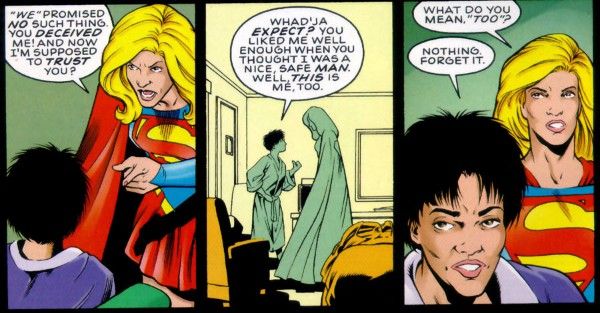
Also, Andy is a supporting character in a superhero book, which is a dangerous role to inhabit. She’s eventually captured and tortured by the major villain of the book and forced to relive her disastrous coming out to her bigoted, abusive parents, as well as her own suicide attempts. The violent imagery of this issue reminds me a lot of what Terry Berg would go through a few years later, especially since Linda only remembers her missing friend’s existence when the plot allows for it. Andy does ultimately get a happy ending, in a relationship with Blithe, a third, conveniently bisexual Earthborn angel, but it doesn’t really make up for the way a queer woman of color’s pain is used to bolster the narrative of our straight, white heroine.
All that said, the series roundly condemns the homophobia Andy is subjected to. And Andy is still one of DC’s first lesbian superheroes, as well as one of their first nonbinary, genderfluid, and/or trans characters, depending on how you interpret her. It’s clear that she was written with a lot of good intentions, and if her portrayal seems flawed in retrospect, that’s in part because characters like Andy helped comics grow to a more progressive place. The fact that she seems dated 26 years after her debut is a good thing, not a bad one.
And honestly, there’s something about both Hero and Comet that remains impressive over two decades later: they know who they are. Despite their bizarre lives, despite the somewhat unpredictable changes their bodies go through, and no matter how other people respond to them, they never allow anyone else to define them. Hero can’t explain why some of his personas are attracted to Sparx, but it never shakes his assertion that he, Hero, is gay. Andy has struggled through years of pain and uncertainty to end up in a place where she clearly loves and believes in herself, with all of her complications. I honestly have trouble imagining DC or Marvel presenting a queer character today with that much of their identity in flux, much less one who simply chooses not to worry about it because they know and like themselves. It’s genuinely refreshing to read.
Neither Hero nor Comet has shown up for over 20 years. Comet is unlikely to make a reappearance, as the Earthborn angel version of Supergirl has been retconned out in favor of the classic Kryptonian version, and even the flying horse version of Comet returned in 2021’s Supergirl: Woman of Tomorrow. I’d particularly love to see Hero make a comeback; the H-Dial has also gone on to new characters, but that’s no reason Hero himself can’t return, either with a new gimmick or just as one of Superboy’s civilian friends.
Either way, Hero and Comet are both fun characters who helped move superhero comics along the path to having two canonically queer members of the Superfamily itself (Jon Kent and Natasha Irons). I’d love to see them come back, but even if they never do, they still paved the way for where we are today.
(But seriously, DC, bring Hero back.)











